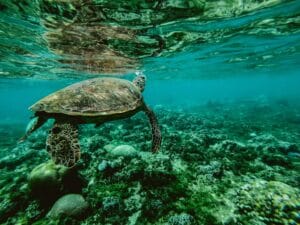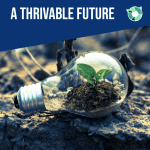Understanding Cryptosporidium: A Stealthy Waterborne Threat
Cryptosporidium remains a hidden yet dangerous waterborne pathogen. It easily spreads through contaminated water sources (Akinnubi, 2024). Once ingested, it causes cryptosporidiosis, a severe gastrointestinal illness (Siwak et al., 2023). Additionally, Cryptosporidium infects both humans and animals, increasing zoonotic transmission risks (Mpindou et al., 2021). Its small oocysts resist many traditional water treatments, making removal difficult (Ahmed & Karanis, 2020). An oocyst is like a tiny egg produced by some parasites. It has a hard outer shell that protects the parasite inside and helps it survive in the environment (like in soil or water). Moreover, outbreaks often go undetected owing to diagnostic challenges and underreporting (Siwak et al., 2023). Climate events and poor sanitation further elevate exposure risks in vulnerable regions (Mpindou et al., 2021). Biosensors and molecular tools offer improved early detection, yet widespread adoption remains limited (Siwak et al., 2023). Public health agencies continue to highlight Cryptosporidium as a priority waterborne threat (Akinnubi, 2024). Overall, understanding its biology, transmission, and detection gaps is essential for protecting water supplies and human health.
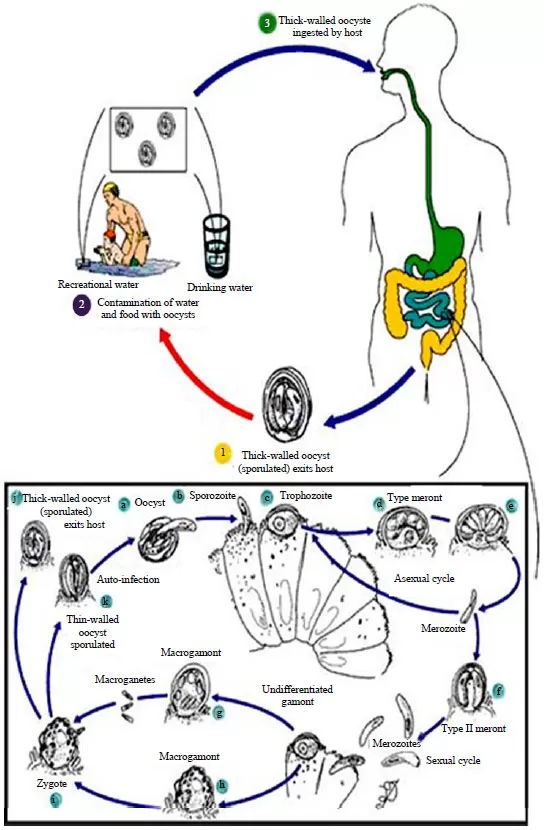
Source: Science Alert, 2015
LIFE CYCLE OF CRYPTOSPORIDIUM
The life cycle of Cryptosporidium starts when a person swallows oocysts, which are tiny, tough, egg-like structures found in contaminated water, food, or faeces. After reaching the small intestine, each oocyst excysts, meaning it opens and releases four sporozoites, the infectious forms of the parasite (CDC, n.d.).
Next, each sporozoite attaches to an epithelial cell, which lines the inner surface of the intestines and helps with digestion and absorption. Once inside the cell, the parasite begins asexual reproduction, a process called merogony, where it creates many new copies called merozoites. After a few cycles, some parasites begin sexual reproduction. This stage produces male forms, called microgametes, and female forms, called macrogametes. When a microgamete fertilises a macrogamete, a zygote forms. The zygote then matures into a new oocyst (MSD Manual, n.d.).
Two kinds of oocysts form. A thick-walled oocyst passes out in faeces and can survive in harsh environments, waiting to infect another person. A thin-walled oocyst breaks open inside the gut, restarting the infection inside the same person. This process is known as autoinfection. Since oocysts resist chlorine and other disinfectants, infections often spread through untreated water or poor hygiene. In people with weakened immune systems, the parasite causes more serious illness because autoinfection keeps increasing the parasite load (University of Saskatchewan, n. d.)
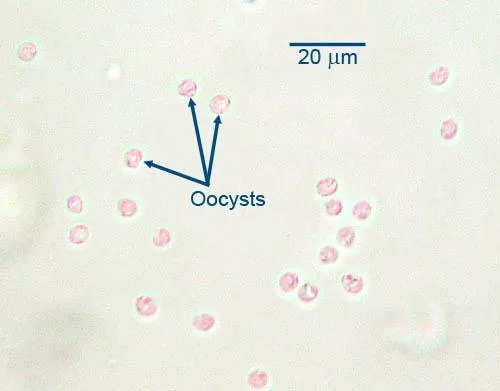
Source: University of Saskatchewan, n. d.
The Impact of Cryptosporidium on Aquatic Ecosystems
Cryptosporidium contamination poses a serious ecological disruption in freshwater ecosystems. Once introduced, these protozoan parasites persist owing to their resistant oocyst stage, surviving for months in lakes, rivers, and wetlands (Hayes et al., 2023). Their presence reduces water quality and creates biological stress for aquatic species. Fish, amphibians, and invertebrates may act as reservoirs, unknowingly amplifying parasite loads within food webs (Golomazou et al., 2021). Additionally, oocysts embed within biofilms, making conventional water treatments less effective and increasing the risk of chronic environmental exposure (Lefebvre et al., 2021).
Beyond ecological damage, Cryptosporidium poses severe threats to human health, especially for communities dependent on untreated water sources. Ingestion of contaminated water during fishing, swimming, or drinking can trigger outbreaks of cryptosporidiosis, a diarrheal disease with high morbidity (Daraei et al., 2021). Vulnerable populations, including children and immunocompromised individuals, face heightened risk. Furthermore, agricultural runoff and extreme weather events driven by climate change accelerate parasite spread and concentration levels (Wang et al., 2023). As Cryptosporidium thrives, it undermines water safety, food security, and biodiversity, creating a hidden but potent barrier to the United Nations’ Sustainable Development Goal 14, Life Below Water, and public health resilience.
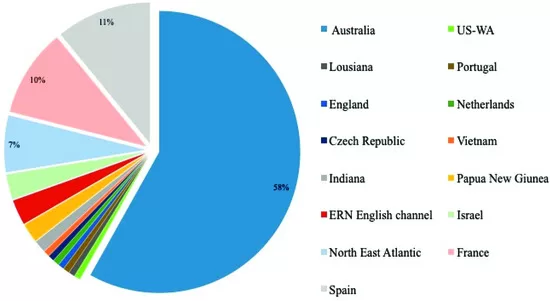
Source: MDPI, 2020
Contaminated Waters and Public Health Risks
The presence of Cryptosporidium in water sources continues to pose a serious threat to public health worldwide. Through Quantitative Microbial Risk Assessment (QMRA), researchers have demonstrated that even low concentrations of Cryptosporidium oocysts in contaminated water can result in significant infection risks (Ryan et al., 2022). Particularly in Australia, studies reveal that recreational activities in contaminated catchments dramatically elevate human exposure levels, making outbreaks more probable during periods of heavy rainfall and runoff (Ryan et al., 2022). This clearly illustrates the hidden but substantial human health vulnerability tied to waterborne Cryptosporidium.
Moreover, in tropical and developing regions, the problem escalates further owing to inadequate wastewater management and insufficient drinking water treatment infrastructure (Mpindou et al., 2021). For instance, in many parts of Africa, emerging waterborne pathogens like Cryptosporidium frequently contaminate surface waters, threatening millions of people daily (Mpindou et al., 2021). Additionally, climate change exacerbates this risk by intensifying flood events and altering water temperatures, which are factors known to enhance Cryptosporidium survival and mobility (Kazimierska et al., 2025). Furthermore, urbanisation and increased discharge of untreated sewage into rivers and lakes continue to amplify oocyst loads in potable water sources (Hassan et al., 2021). Consequently, these compounded factors highlight the urgent need for robust water quality monitoring and advanced treatment solutions globally.
Challenges in Detection and Water Treatment
The detection and removal of Cryptosporidium from water systems remain persistent challenges in safeguarding both public health and aquatic ecosystems. Despite significant technological advancements, traditional water treatment processes like chlorination often fail to inactivate Cryptosporidium oocysts owing to their thick-walled, highly resistant structure (Hassan et al., 2021). Consequently, these oocysts frequently survive through drinking water treatment plants, entering public supply systems undetected.
Moreover, the complexity of isolating and identifying Cryptosporidium in water matrices presents substantial barriers. For instance, current detection methods like microscopy, immunofluorescence assays, and PCR, often suffer from limitations in sensitivity, speed, and operational cost (Luka et al., 2022). Even more sophisticated biosensors and nucleic acid-based technologies, though promising, are still under refinement and are not widely deployed in low-resource settings (Siwak et al., 2023).
In addition to technological hurdles, environmental factors further complicate detection and removal efforts. Seasonal rainfall, agricultural runoff, and increasing wastewater discharge all contribute to fluctuating oocyst loads in surface waters (Mpindou et al., 2021). Consequently, the unpredictable nature of Cryptosporidium contamination makes it difficult for water treatment facilities to anticipate and respond in time. These ongoing detection and treatment challenges not only elevate the risk of human waterborne outbreaks but also threaten the integrity of freshwater habitats by allowing parasite persistence.
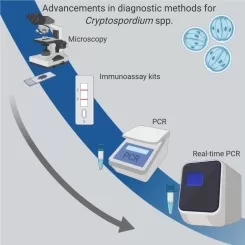
Source: Science Direct, O’Leary et al., 2021
Cryptosporidium’s Role in Water Quality Decline
Cryptosporidium severely degrades water quality. It increases turbidity, limiting light and reducing oxygen levels (Daraei et al., 2021). Consequently, aquatic habitats suffer oxygen depletion and biodiversity loss (Lefebvre et al., 2021). Moreover, runoff and stormwater continuously introduce new oocysts, especially after heavy rains (Wang et al., 2023). This can often result in contaminated water that poses risks to both ecosystems and human health. As a result, contamination peaks seasonally, straining water treatment systems (Mpindou et al., 2021). In addition, Cryptosporidium embeds within biofilms, evading standard disinfection (Lefebvre et al., 2021). This persistence further raises microbial risks for consumers who may be exposed through contaminated water supplies. Furthermore, its presence often signals broader pollution, suggesting faecal contamination and other pathogens (Ahmed & Karanis, 2020). Climate change worsens this, promoting oocyst survival during floods and heatwaves, which can increase the spread of contaminated water across larger areas (Wang et al., 2023). Lastly, routine monitoring often misses low oocyst levels, delaying response actions (Hassan et al., 2021). Overall, Cryptosporidium remains a key driver of water quality decline and a public health concern.
Toward Safer Waters: Monitoring, Policy, and Prevention Strategies
Effective Cryptosporidium control starts with strong monitoring systems. Many countries now use molecular methods like qPCR for real-time detection (Akinnubi, 2024). Additionally, One Health approaches link human, animal, and environmental surveillance to track outbreaks early (Innes et al., 2020). One Health is an integrated, unifying approach that aims to sustainably balance and optimise the health of people, animals, and the environment (WHO, 2017). Regular water testing and improved diagnostic tools help reduce contamination risks (Hassan et al., 2021). Moreover, environmental health practitioners stress maintaining proper chlorine levels and enforcing strict pool policies (Cullinan et al., 2020). National surveillance networks, as seen in Argentina, further strengthen prevention efforts (Rivero et al., 2025). Importantly, policymakers are updating regulations and adopting rapid response strategies (Feng et al., 2021). Public education campaigns also raise awareness about safe water practices (Helmy & Hafez, 2022). Together, these actions build a multi-layered defense against Cryptosporidium.
Conclusion and Call to Action (CTA)
Cryptosporidium remains a persistent and growing threat to global water security, public health, and aquatic ecosystems. Its ability to evade conventional water treatment and survive under diverse environmental conditions reflects both a scientific and governance failure. Despite advancements in detection technologies and growing awareness, many countries still struggle to meet critical Sustainable Development Goals, especially SDG3: Good Health and Well-Being, SDG6: Clean Water and Sanitation, and SDG14: Life Below Water. The THRIVE Framework offers a powerful pathway for change by encouraging Systems Thinking, Science-Based Targets, and Integral Thinking.
Moving forward, policymakers, researchers, and community stakeholders must collaborate urgently. Governments must strengthen water quality regulations and monitoring systems. Public health agencies should expand One Health surveillance and outbreak response capacity. Communities need education on safe water practices. Above all, integrated, context-based strategies must drive national and local actions. Only through collective, science-informed efforts can we reduce Cryptosporidium risks and achieve water safety for all.
Achieving THRIVE goals
Viewing Cryptosporidium contamination through the lens of the Sustainable Development Goals (SDGs) is essential because it highlights the interconnected nature of health, water, ecosystems, and climate resilience. Currently, several SDGs remain unmet.
SDG3: Good Health and Well-Being
Cryptosporidium causes severe diarrheal illness, especially in children and the immunocompromised (Beder & Taşbent, 2025). Yet, health systems fail to detect outbreaks early. Diagnostics often miss low oocyst levels (Kurator et al., 2025). Underreporting delays response. Rural clinics lack testing tools. Public awareness is low. People unknowingly drink contaminated water. Consequently, disease spreads silently, worsening health vulnerabilities.
SDG6: Clean Water and Sanitation
Cryptosporidium resists chlorination and conventional filtration. However, most treatment plants still use outdated processes. Sewage and agricultural runoff enter rivers untreated. Infrastructure gaps allow parasite survival. Rainfall and flooding spread oocysts widely. Monitoring tools remain limited (ELKhadry et al., 2025). Contamination goes undetected until outbreaks occur. Thus, water safety goals remain unmet in many regions.
SDG14: Life Below Water
Cryptosporidium disrupts aquatic ecosystems. Fish, amphibians, and invertebrates act as hidden reservoirs. Reservoirs are any person, animal, plant, soil, or substance, or a combination of these, in which an infectious agent normally lives and multiplies. From the reservoir, the pathogen can be transmitted to a susceptible host, either directly or indirectly. Oocysts persist in wetlands and biofilms for months. Yet, ecosystem monitoring often excludes microbial threats. Runoff, urban waste, and bioaccumulation amplify impacts. Aquatic biodiversity declines under invisible parasitic pressure.
A Thrivable Framework
The article aligns most closely with five THRIVE Framework elements. First, it embodies Systems Thinking by interlinking water quality, health outcomes, and policy gaps. Additionally, it reflects Complex Wicked Problems, recognising that Cryptosporidium control involves multifaceted, interdependent challenges with no simple solutions. The emphasis on molecular diagnostics and surveillance aligns with Science-Based Targets, pushing for evidence-based interventions. Moreover, it showcases Integral Thinking by merging ecological and human health impacts within a single narrative. This approach helps translate scientific findings into actionable public health strategies.
Furthermore, by addressing water scarcity and treatment limitations, the article reflects the Finite Resources principle. However, it could enhance alignment by incorporating more Context-Based Metrics and applying the Entity Model to track stakeholders’ specific roles. Overall, the article effectively uses multiple THRIVE elements to frame Cryptosporidium as a cross-sectoral issue requiring integrated, science-led, and policy-driven solutions for long-term water security and public health protection.
To learn more about thrivability, head to the THRIVE website. Here, you can find published articles, whitepapers, and presentations on a range of thrivable topics. More resources can also be found on the THRIVE YouTube channel. Be sure to sign up for the newsletter and attend the monthly webinars. To contribute more to THRIVE, please consider applying as a volunteer.




